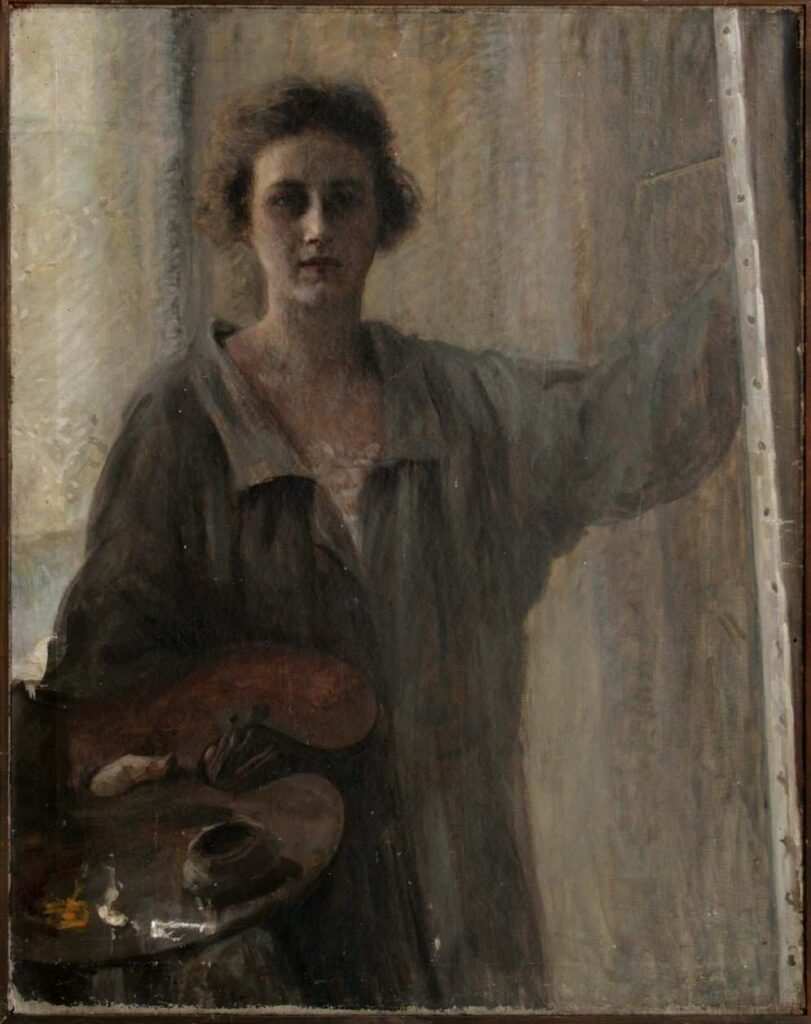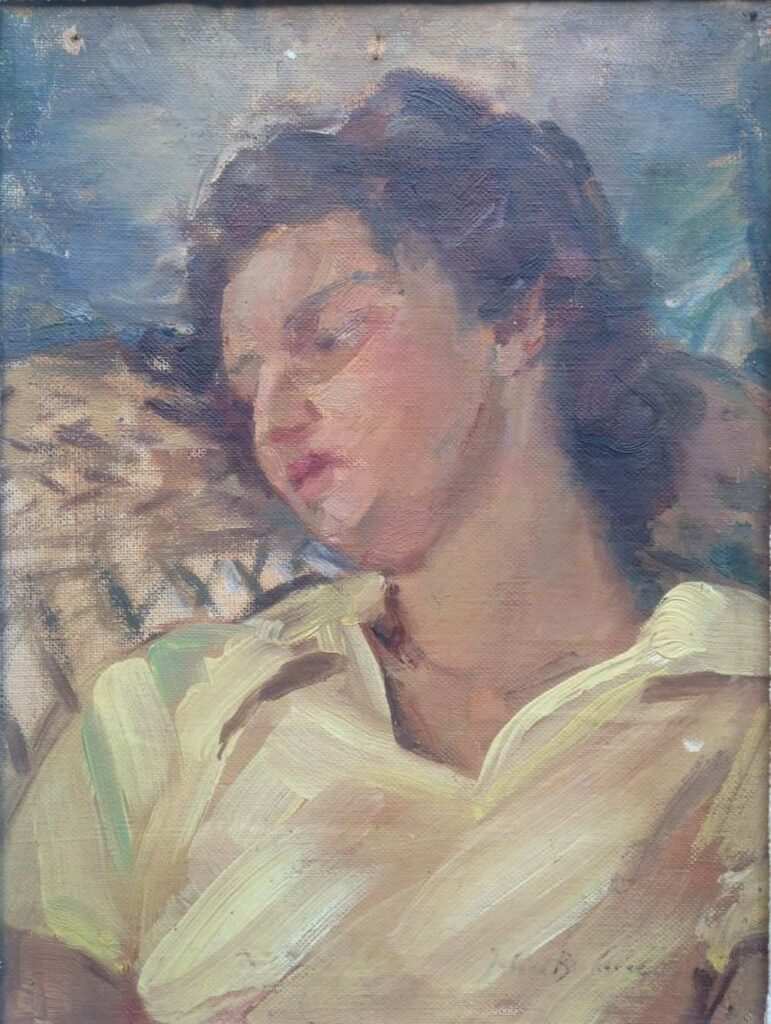Jelica Bukovac, the third child of Vlaho and Jelica Bukovac, was born in Zagreb on 19th August 1897. She spent the first year of her life in a magnificent, newly built house at the Zrinjevac square, where her older brother Ago and sister Marija played in the yard in front of her father’s studio.
Art and painting, along with frequent relocations, were a part of her life since an early age. Dissatisfied with the current policy towards young and progressive artists in the newly founded Croatian Association of Artists, Vlaho Bukovac relocated with his family from Zagreb in the following year, leaving a comfortable residence and workspace and returning to the family home in Cavtat.
The next four years were spent in a peaceful and relaxed environment among relatives and acquaintances, after which the family relocated to Vienna, where they would spend one year. Bukovac was preparing an exhibition and thus rented a larger space for painting, to which his children were always welcome. At the end of 1903, they ultimately found their home in Prague. It would be a new home for Bukovac’s children, where they would find their place, unlike their father. His daughters would receive education and form a circle of friends, while his son, Ago, would receive his secondary education in Dubrovnik. In fact, the happiest days of Jelica’s life are related to her childhood and girlhood spent in Prague.
Bukovac would most often choose his daughter Jelica as a model for his portraits. U salonu (In the Lounge), U iščekivanju (Anticipation), Patricijka (Young Patrician Lady), Gatalica karata (A Fortune Teller) and Smiješak (A Smile) are just some of the many paintings in which Jelica is portrayed. These paintings typically depict a young girl in a semi-figure, sitting, placed in the interior in front of the elements common in Bukovac’s paintings: draperies, tapestries, furniture, etc. Due to Bukovac’s inability to travel and to visit his hometown during the First World War, fragments of his apartment in Prague were the primary setting in his paintings from that period.
Vlaho would paint portraits of his wife and children under various lighting and with objects that can still be found in the collection in House Bukovac. In 1913, Jelica and her sister Ivanka accompanied their father to Zagreb, where they spent a month setting a large composition titled Razvitak hrvatske kulture (The Development of Croatian Culture) in the University Library building. Bukovac painted a series of portraits of historical figures related to Croatian culture, while the outline of the painting was the apotheosis of Ivan Gundulić being crowned with a laurel wreath by a fairy while kneeling before the goddess Athena sat on a throne. Bukovac added an air of joviality to a solemn scene such as a procession of serious and important personalities of Croatian history with his playful depictions of fairies in fluttering dresses. The portrait of his daughter Jelica is reflected in the faces of the fairies. Adopting various postures, she served as his model for all the fairies depicted in the painting in question.
Much like her younger sister Ivanka, Jelica also inherited her love of art from her father. Already at the age of 17, she and her sister Ivanka began receiving her first serious painting lessons from her father. In Ivanka’s notes, we learn that Bukovac was not lenient with his daughters. Since they were always with him while he was painting in the studio, he called them his “little colleagues”.
`I would spend all my free time with my sister Ivanka in my father’s studio, so I often posed as a model for his potraits. Such inspiring atmosphere was pivotal to my sister and I developing a love for painting.‘
Jelica Bukovac enrolled in the Prague Academy of Fine Arts as a full-time student in 1921, initial in the class of her father; after his death, she moved to the class of Professor Nechleba and later to that of Professor Thiele. In 1924, her studies were interrupted by her marriage; following the divorce from her husband, General Lazar Radosavljević, she returned to Prague in 1937.
While writing her short autobiography on the occasion of the exhibition at the Art Gallery in Dubrovnik in 1958, Jelica noted, `Life at the parents’ house was ideal – full of love, harmony and spiritualised through work; Ivanka and I studied painting while our sister Marija studied music. In short, it was in such stark contrast to my married life.’
Jelica had two daughters, Marija and Jelica (nicknamed Lele). Jelica Bukovac returned to Prague in order to continue her education and graduated in the class of Professor Obrovski in 1939; during that time, her daughters stayed in Belgrade due to their educational obligations and would visit her in Prague.
Jelica reflected on that period in her life, “I worked a lot on figural painting, portraits and even still life; the most prolific time in my career was from the time when I was completing my studies until the beginning of the war. One of my studies of a young woman from that time is kept in the Gallery of Fine Arts in Zadar. At that time, I was preparing an exhibition which was to take place first in Prague and then in our home country, but my best efforts to do so were thwarted by Hitler’s entry into Prague, so I immediately set off, unable to bring anything to my children, who remained in the institution in Belgrade.
During the Second World War, Jelica moved to Cavtat with her daughters, where she took care of her gravely ill mother and could thus no longer devote herself to painting. Later, she was occupied by the Bukovac Gallery, where she served as a permanent interpreter for both local and foreign visitors.
Fate was not kind to Jelica Bukovac. Her daughter Marija, a journalist and student at the Faculty of Philosophy in Belgrade, took her own life on 29th July 1954, while her other daughter, Jelica, a graduate of The Academy of Applied Arts, passed away after a long and severe illness on 15th July 1955.
Following these unfortunate events, Jelica made only a brief remark in her notes, stating, “Everything stood still.” She passed away in Cavtat on 16th January 1967 and was buried with her daughters in the St. Roko Cemetery.




